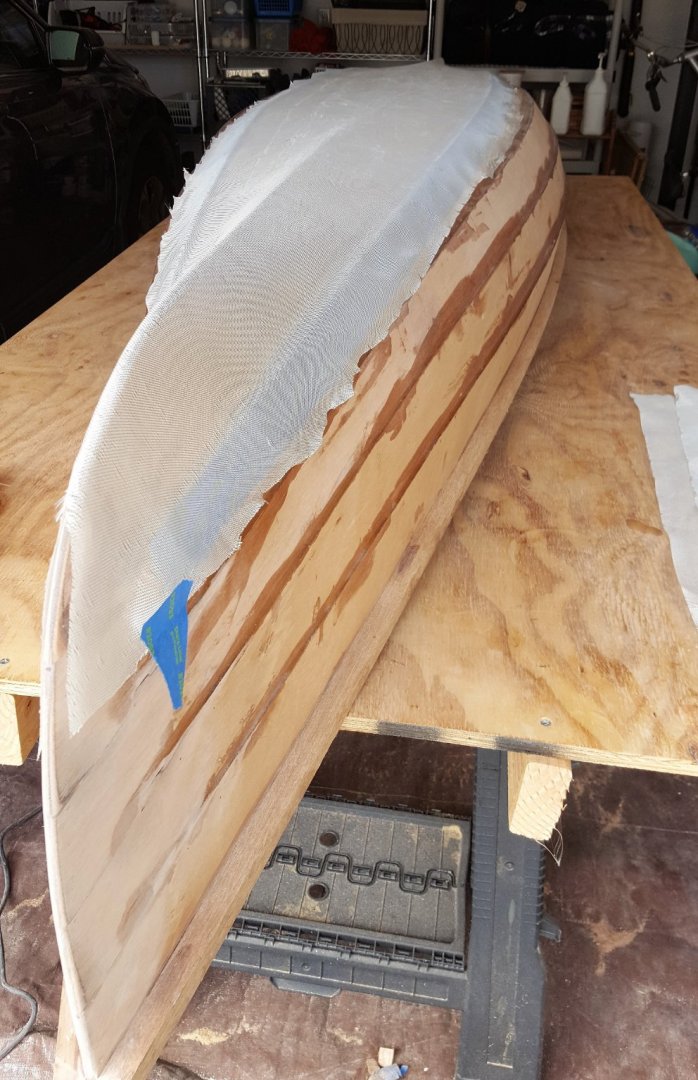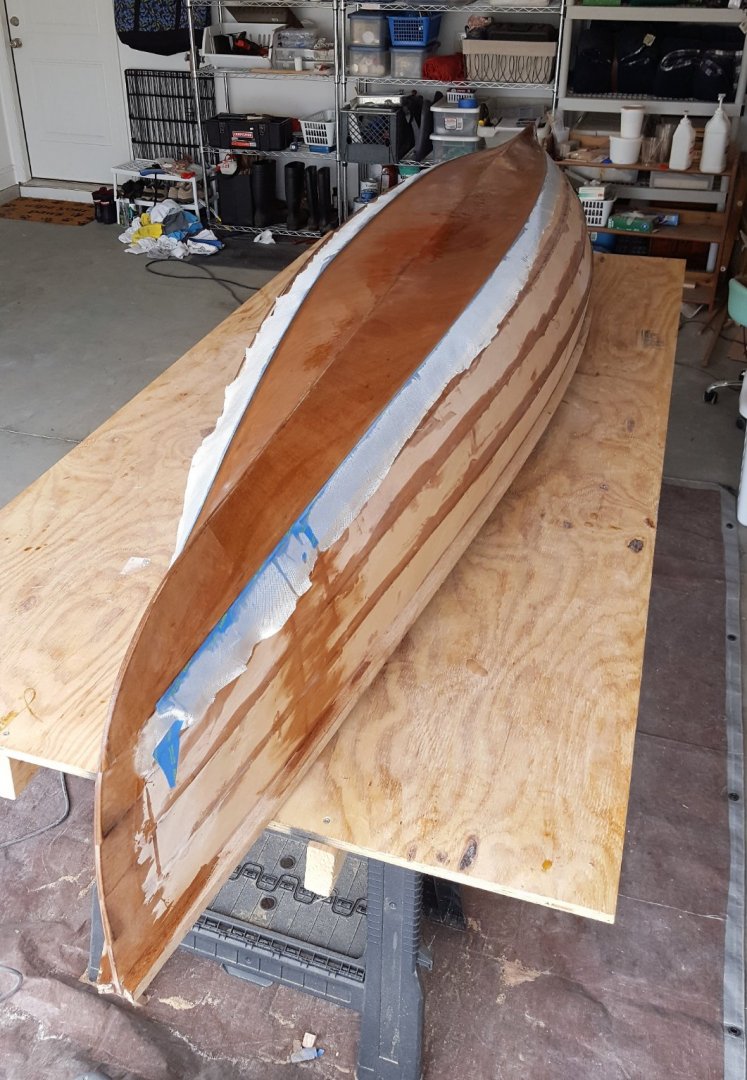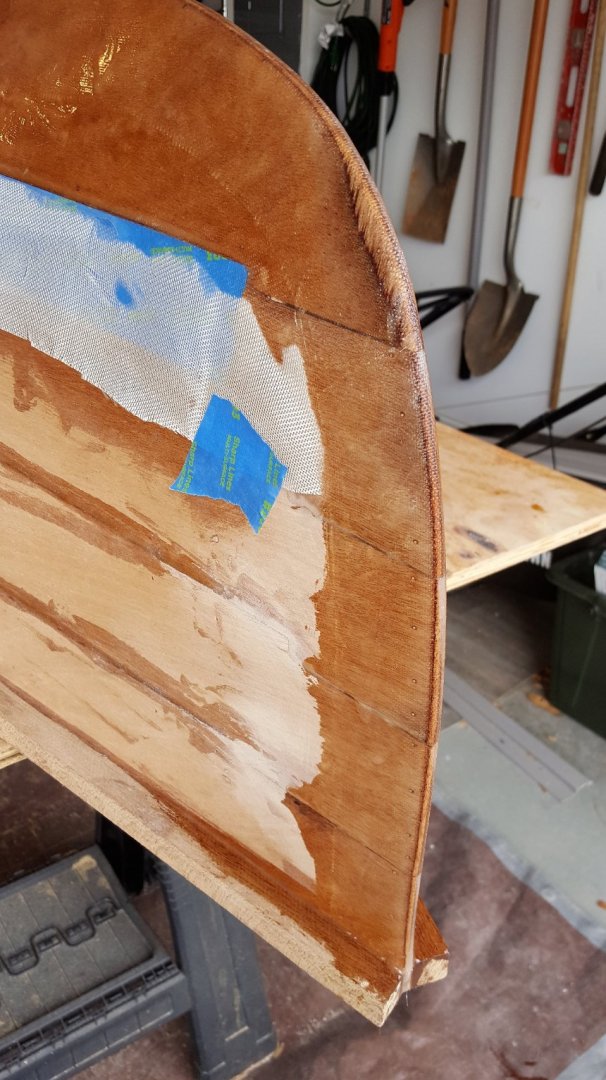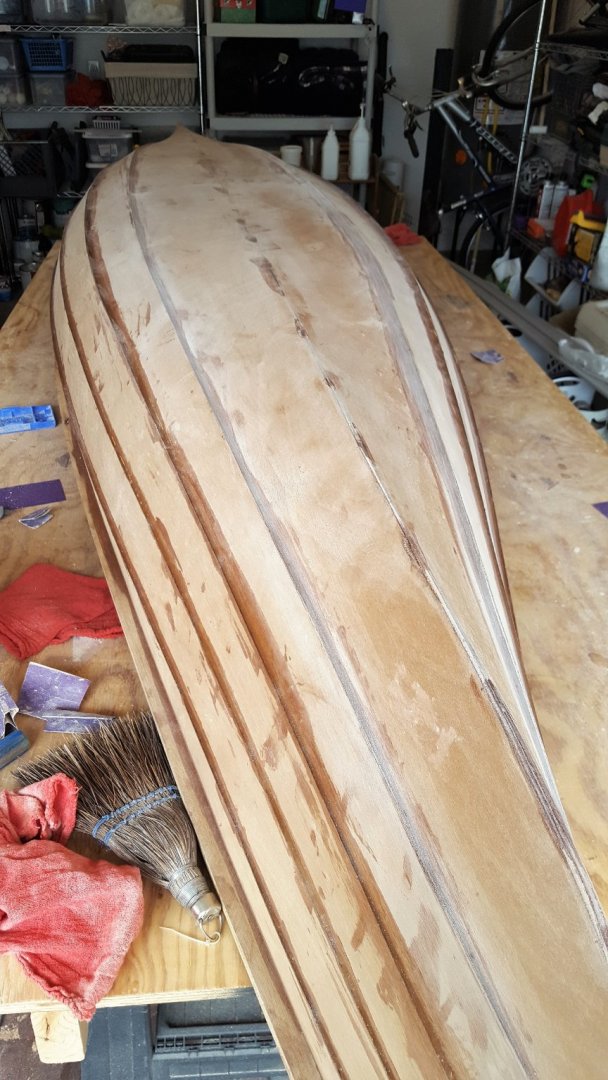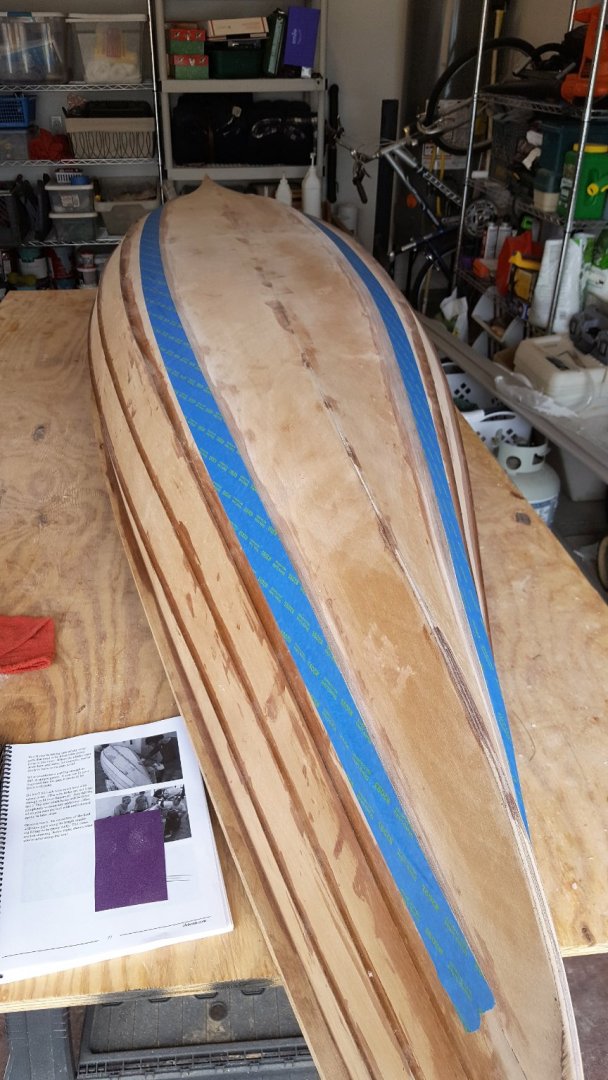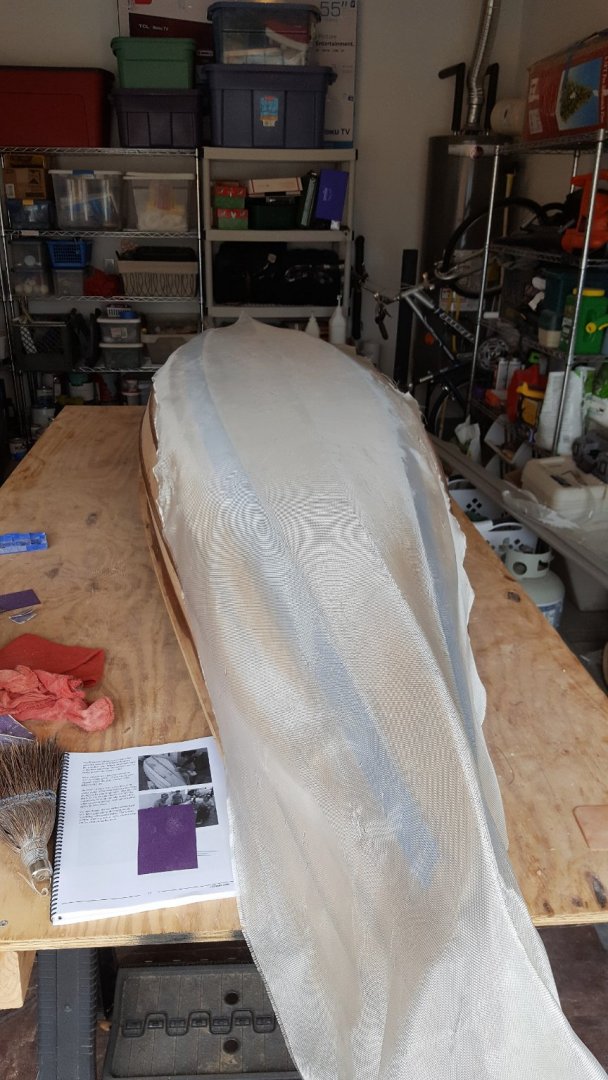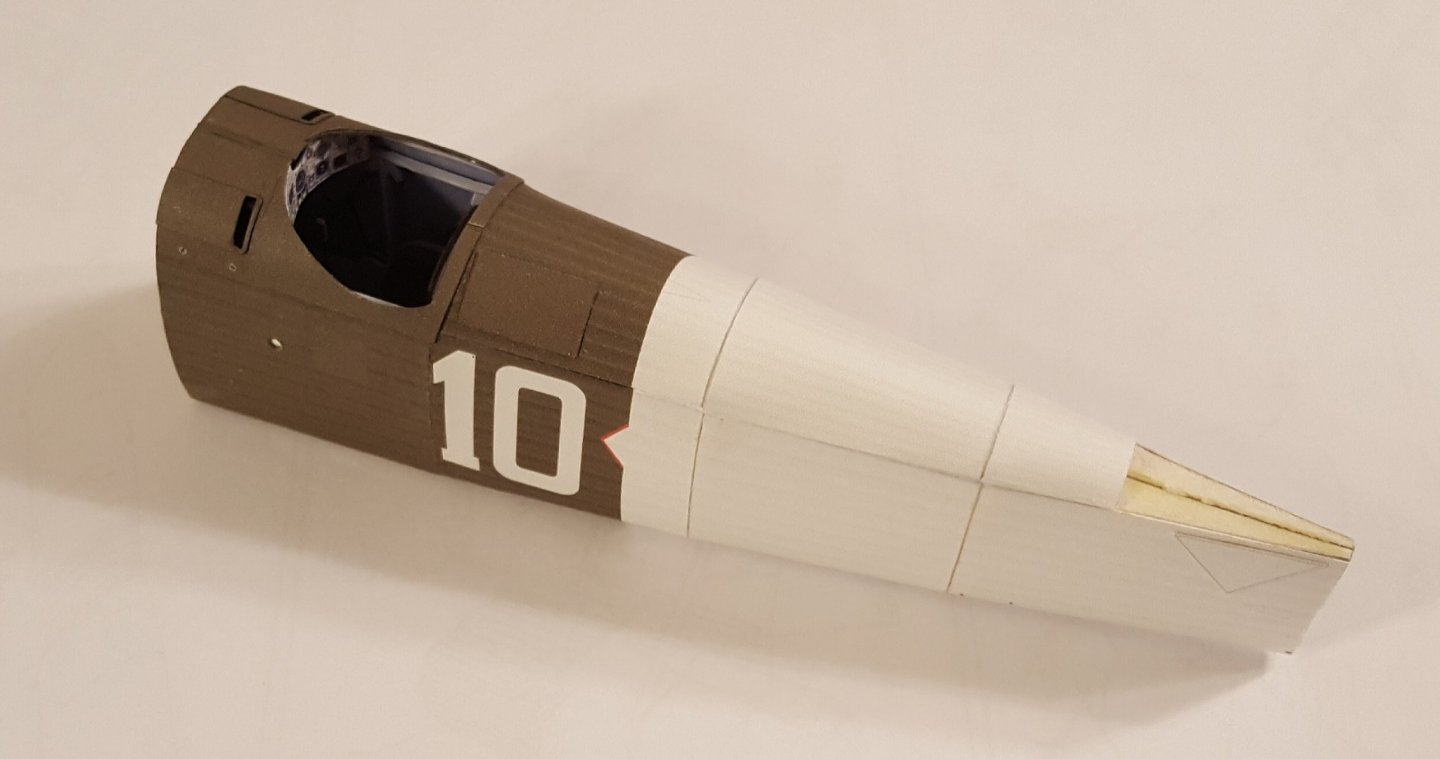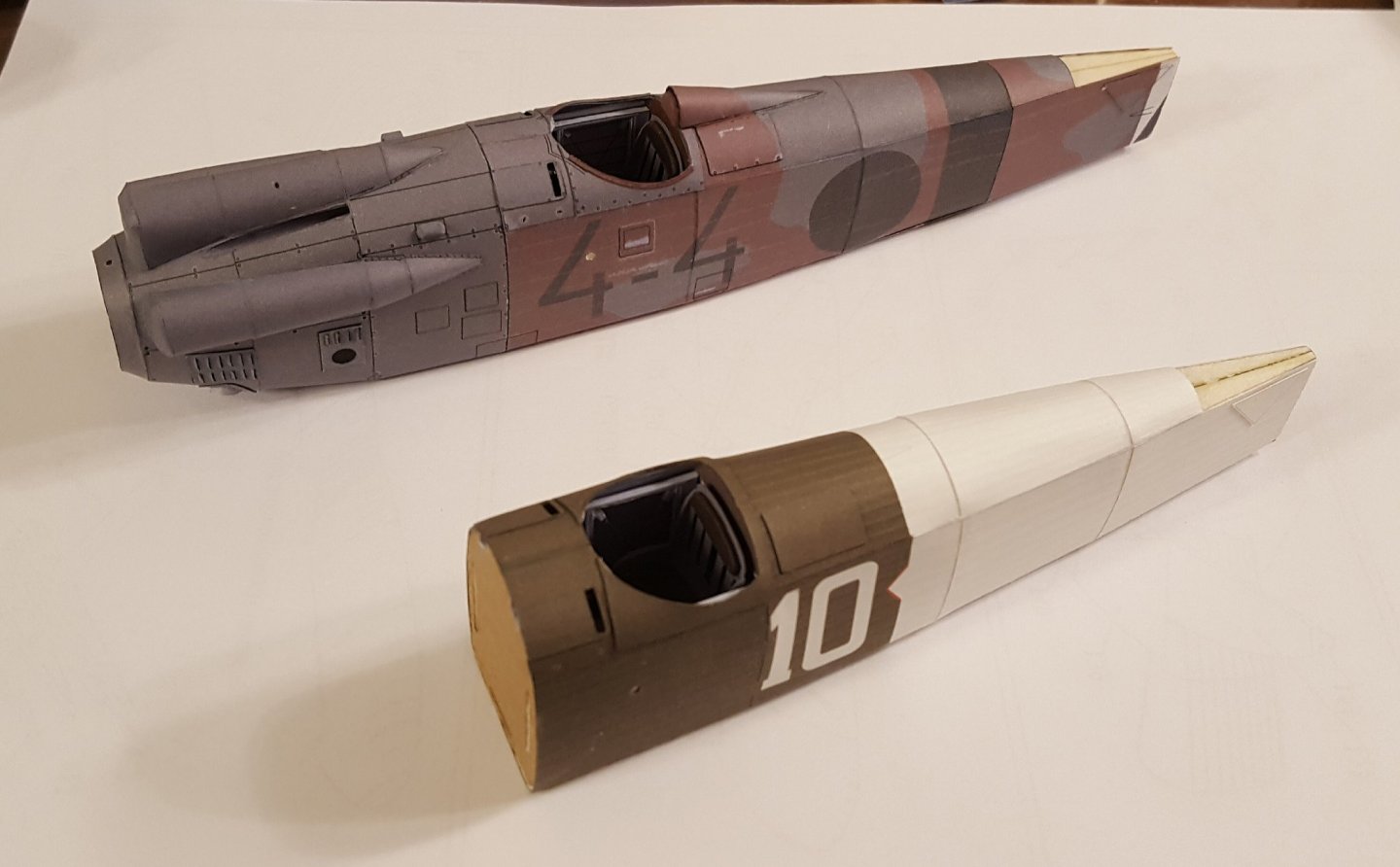-
Posts
10,423 -
Joined
-
Last visited
Content Type
Profiles
Forums
Gallery
Events
Everything posted by ccoyle
-
Well, the weekend came back around, which means it was time for the final bit of fiberglass work. I think I finally got the handle on how to work with the stuff, so this step only took me about 90 minutes to complete. As our friends from across the pond say, I'm quite chuffed about how this turned out. Last night I trimmed the fiberglass cloth and cleaned up my work area. The instructions said nothing about slitting the cloth at the ends, but of course the draped cloth naturally wants to create folds there. I made just enough of a cut to allow the cloth to hug the sides neatly, then tacked the ends with tape. Applying the resin went lickety-split this time around. I worked with small batches, and it took six batches to do the entire job. The flatter portions I worked with a spreader, and the ends were finished off with a disposable chip brush. An extra piece of 4" wide cloth covers each end. I cut darts into each strip about half-way into the curved portion to eliminate some of the pucker. Once this is cured and trimmed, it will be time to seal the entire canoe with two coats of unthickened epoxy.
-
Long answer: Models are kind of a gray area in copyright law, but the governing principle in IP protection is the question of whether there is potential, intentional or not, to defraud the original IP owner. Since you are building a one-off model from scratch, as opposed to designing a kit with the intent to market it, you are neither defrauding the author's estate nor any of the production companies involved in making the film (and there were so many of the latter that I'd wager it'd be difficult to find out who actually owns the IP rights to the film version). In any case, all of the representations of the fictional Unicorn, book and film, look like late-17th century two-decked men-of-war, so you could hardly be faulted for building a generic ship of that type and calling it "Unicorn." This is quite different from the examples of Black Pearl and Flying Dutchman from the POTC universe; in their cases, the unusual appearance of each ship is a highly creative work protected by IP law. Even then, though, you'd likely be safe if you were building only a one-off model for yourself. Short answer: Yes, you can post pictures.
-
That's a very handsome model -- congratulations!
- 146 replies
-
- artesania latina
- bluenose ii
-
(and 1 more)
Tagged with:
-
Correct, but bear in mind that the amount that you need to remove from each bulkhead may change slightly from top-to-bottom. Use a planking strip to check your progress. Ideally, at each bulkhead the plank should lie flat across the edge with no sharp bend in the plank and no gaps between it and the bulkhead. It's one of the skills that comes with the territory -- you'll get the hang of it.
-
No worries! In fact, you still have a lot of sanding left to do! The blocks you have glued in at the bow and stern -- the filler blocks -- need to be sanded to match the contours of the false decks above them and the bulkheads adjacent to them. The bulkheads also need to be bevelled so that your planks will not form a sharp kink at each bulkhead. You'll want your planks to form smooth curves from stem to stern. Midship bulkheads require little bevelling, if any, but those at the bow and stern may need quite a bit, especially on bluff-bowed subjects like Halifax. Good luck!
-
"Told by whom?" is the question. $800? Sheesh! 🙄
- 749 replies
-
- albertic
- ocean liner
-
(and 2 more)
Tagged with:
-
Dia dhuit! Search through the build log index. There are several builds of this kit in progress.
-
Merging of topics needs to be done by a moderator. Adding to an existing log is done simply by using the reply window after the most recent post, just as you replied in this topic.
- 30 replies
-
Fixed! Michael, I really do hope your fine restoration effort finds a worthy new home.
- 749 replies
-
- albertic
- ocean liner
-
(and 2 more)
Tagged with:
-

Papegojan 1627 by mati - FINISHED - 1/48
ccoyle replied to mati's topic in - Build logs for subjects built 1501 - 1750
Fantastic work -- worth the wait! -
Ah, I have been eagerly awaiting this post ever since you updated us about the flag halyards. What a splendid result! I hope you will create a gallery album for us. Cheers!
- 356 replies
-
- red jacket
- finished
-
(and 1 more)
Tagged with:
-
Welcome aboard! BlueJacket's owner, Nic Damuck, and one of their designers, Al Ross, are both members here. I'm sure they'll be interested in seeing your project get underway. Cheers!
-

Introducing Colin. Currently living in South East England.
ccoyle replied to colpatben's topic in New member Introductions
Welcome, Colin! Not sure what kind of morality question plays into it, but you are certainly welcome to post your log here, and based on your previous models I expect that your Le Superbe will be, well, superb!
About us
Modelshipworld - Advancing Ship Modeling through Research
SSL Secured
Your security is important for us so this Website is SSL-Secured
NRG Mailing Address
Nautical Research Guild
237 South Lincoln Street
Westmont IL, 60559-1917
Model Ship World ® and the MSW logo are Registered Trademarks, and belong to the Nautical Research Guild (United States Patent and Trademark Office: No. 6,929,264 & No. 6,929,274, registered Dec. 20, 2022)
Helpful Links
About the NRG
If you enjoy building ship models that are historically accurate as well as beautiful, then The Nautical Research Guild (NRG) is just right for you.
The Guild is a non-profit educational organization whose mission is to “Advance Ship Modeling Through Research”. We provide support to our members in their efforts to raise the quality of their model ships.
The Nautical Research Guild has published our world-renowned quarterly magazine, The Nautical Research Journal, since 1955. The pages of the Journal are full of articles by accomplished ship modelers who show you how they create those exquisite details on their models, and by maritime historians who show you the correct details to build. The Journal is available in both print and digital editions. Go to the NRG web site (www.thenrg.org) to download a complimentary digital copy of the Journal. The NRG also publishes plan sets, books and compilations of back issues of the Journal and the former Ships in Scale and Model Ship Builder magazines.


